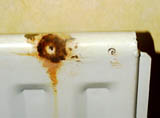




Some bacteria can attack metal. One such organism is called Desulfovibrio vulgaris and it is responsible for much damage to iron and steel structures such as pipes, oil rigs and ships. It does not "eat" or live on iron as such, but it uses some simple chemistry, associated with iron, to provide itself with energy. In the process the iron rusts or corrodes away.

Damage to this radiator, part of a domestic central heating system, may have been caused by bacterial corrosion.
What happens is this: When iron is exposed to water and air, it can rust quite quickly. Atmospheric oxygen and water molecules in contact with the iron, form ferric hydroxide and other oxides of iron. The process, however, frees hydrogen atoms and these form H2 molecules. These molecules cling to the surface of the iron object and form a barrier that prevents the water and oxygen coming in contact with the iron, and so inhibits further rusting. The process is effectively self-controlling. Corrosion stops, unless the hydrogen is removed. Above ground this is highly likely, through mechanical processes such as air flow.
On the other hand, something buried in the ground - a pipe, for instance - in soil such as clay, is completely undisturbed and has no contact with atmospheric oxygen. It should quickly build up a hydrogen coat and should not rust. What is more, it is effectively in anaerobic conditions. The corrosion process should be inhibited. However, it is often found that buried iron is completely destroyed, so how can this be?
The answer is the Desulfovibrio bacterium. It lives in the ground in anaerobic conditions and hydrogen is something it needs to reduce soil sulfate compounds to sulfides. This is its "food", its energy source. It removes the hydrogen from around the metal and lets the water into contact with the iron again. More hydrogen is produced, to feed more bacteria, and gradually the iron rusts away. This time the resulting compound is iron- sulfide, which is easily identifiable. We can always tell if Desulfovibrio is lurking.
Iron and iron compounds are not used to any extent in the construction of Space Stations, but there are other bacteria and micro-organisms that cause corrosion of other materials. On Earth these metal munchers are a considerable nuisance and in space, if allowed to be free on a Space Station for instance, they could be devastating. It is also alleged that the synthetic rubber of the hatch and door seals on spacecraft have been damaged by microbial or fungal attack.
On Earth, engineering fluids such as fuel-oil and hydraulic oil can become victim to fungal and bacterial attack. The Canadian Armed Forces experienced such an attack in 1992, when one of their ships was found to have an infestation of the fungus Hormoconis resinae in its fuel system. This formed thick slime mats and strands throughout the storage bunkers, pipes, and gas-turbine engines of the ship. Removing, cleaning and disinfecting the system was a mammoth and expensive task.
Fuel manufacturers include fungal inhibitors and anti-bacterial agents in fuels, but even these are sometimes overwhelmed by a sustained attack. Micro-organisms can evolve and adapt to conditions that, to earlier generations of their kind, were fatal.
Go
to
Home
| Space Station
| Mars | Rainforest
© 1999 Satellite Events Enterprises Inc.
